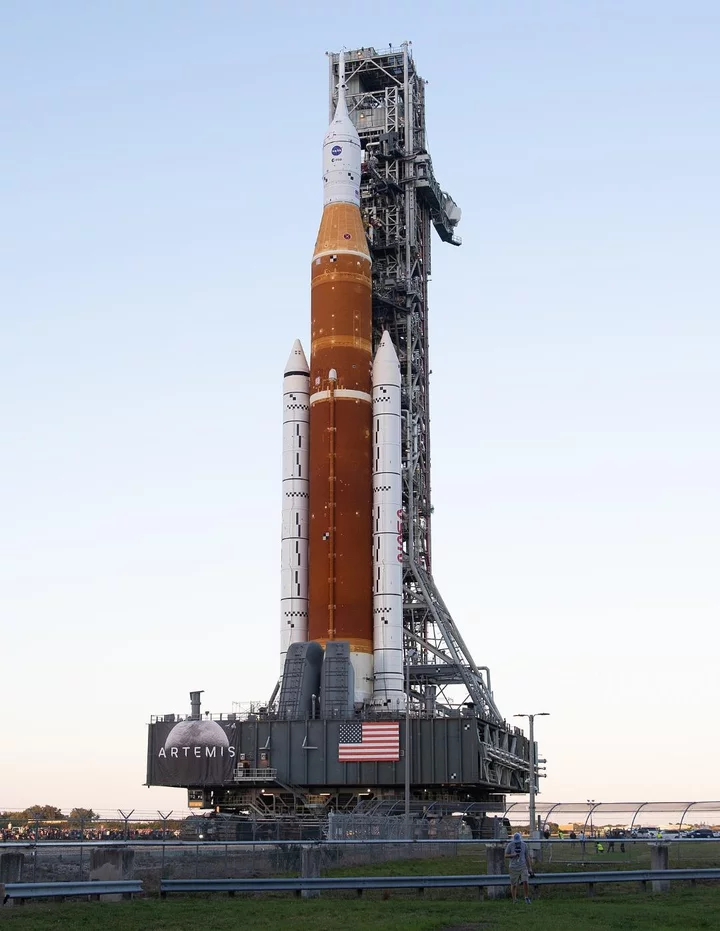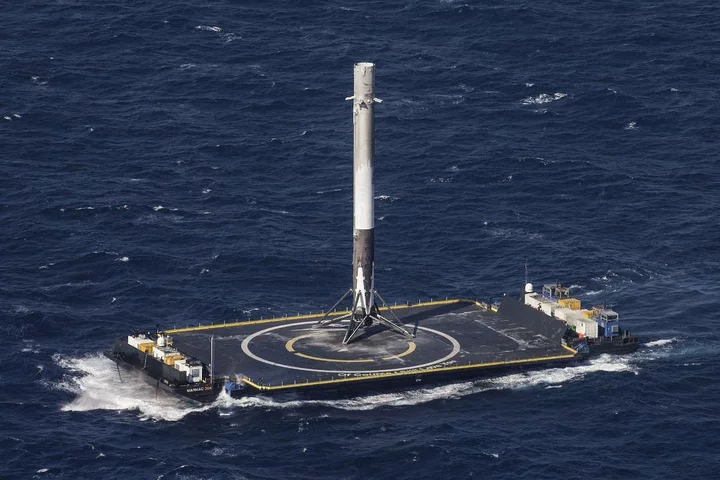A week ago, when NASA scrubbed the second attempt at launching the huge — 320 feet tall, 3,000 ton — moon-bound Artemis 1 rocket, veteran space geeks shook their heads, muttering, “It’s the hydrogen, stupid.” While this was the second time the launch had been scrubbed (the first was a few days earlier), it was actually the sixth time NASA had tried — unsuccessfully — to fill Artemis’ cavernous hydrogen tank. At the last attempt, the tank was only 11% filled when a hydrogen leak was detected in the 8-inch quick-connect fueling line, causing the launch to be called off. Mid-October is now the earliest possible launch date.
First rollout of Artemis 1 (Space Launch System plus the Orion capsule), March 2022, before being rolled back for repairs. (NASA)
Big rockets use three types of fuel, not counting the solid rocket boosters. The Saturn rockets which launched the Apollo missions of the 1960s and early 1970s used kerosene for their main engines: not the most efficient, but cheap and relatively easy to handle. The space shuttle used liquid hydrogen (H2) in its three RS-25 engines. All of Elon Musk’s SpaceX Raptor engines use liquid methane (CH4). Asked about the failure of Artemis to fill its hydrogen tank successfully, Musk tweeted, “Raptor design started using H2, but switched to CH4. Latter is best combo of high efficiency and ease of operation imo.” (All three fuels use liquid oxygen, LOX, as the oxidizer.)
Musk’s opinion is worth noting, seeing as how SpaceX is successfully launching, on average, one reusable rocket every week, while the NASA Artemis program calls for one launch about every two years — with zero usable components (not even the boosters, which were recovered after shuttle launches). Oh, at a cost of some $4 billion per launch…
Hydrogen is a spectacularly poor choice for rocket fuel, as shown by the many problems it caused with the shuttle. The hydrogen molecule is the smallest molecule in the universe, meaning it can leak through the very smallest gap ( — welding Artemis’ hydrogen tank is a nightmare, apparently). And liquid hydrogen is cold, so cold that any metal coming into contact with it tends to brittleness. To prevent liquid hydrogen from boiling (at -253 degrees C), the tanks have to be insulated, adding to the weight and bulk of a rocket using hydrogen fuel. Hydrogen is six times less dense than methane, so a hydrogen-fueled rocket is much larger (and heavier and more costly) than an equivalent methane-fueled rocket. Methane is cheap, doesn’t leak easily because it’s a much larger molecule than hydrogen, and, with a boiling point of –162 degrees C, can be stored using a passive cooling system. And it can probably be produced synthetically on Mars, so a manned Mars mission won’t have to leave Earth with fuel for the return trip.
Overall, hydrogen is a more powerful fuel, which is why it was chosen for the space shuttle, but its delta-V (a rough measure of overall efficiency) is roughly the same as that of methane, after taking all the above into account.
So why is NASA still using liquid hydrogen? Because that’s what the shuttle’s engines used and Artemis 1’s four engines are RS-25 engines which have previously flown on shuttle flights. That’s right, they’re rebuilds, 30-year old engines using a poor choice of fuel. And that’s all about politics. After Barack Obama tried to shut down Artemis’ predecessor, Constellation, 12 years ago, Congress responded by reviving the program, spreading the wealth around the country (to keep constituents happy and Constellation workers employed), specifically mandating that the Artemis program use “existing United States propulsion systems, including liquid fuel engines…” NASA engineers are about as smart as they come — they know all about the problems you get when you use hydrogen as rocket fuel, of course. But, you know, in the real world, money trumps smart technology.
I did mention, didn’t I, that all of SpaceX’s components are recoverable? One of their Falcon 9 first-stage booster rockets has now landed safely on a floating platform and been reflown 12 times.
Sigh. Politics.
Meanwhile, here’s the Big Question: Why are we going back to the moon???
First stage of a SpaceX Falcon 9 after landing on an autonomous drone ship. (SpaceX, donated to public domain)


CLICK TO MANAGE